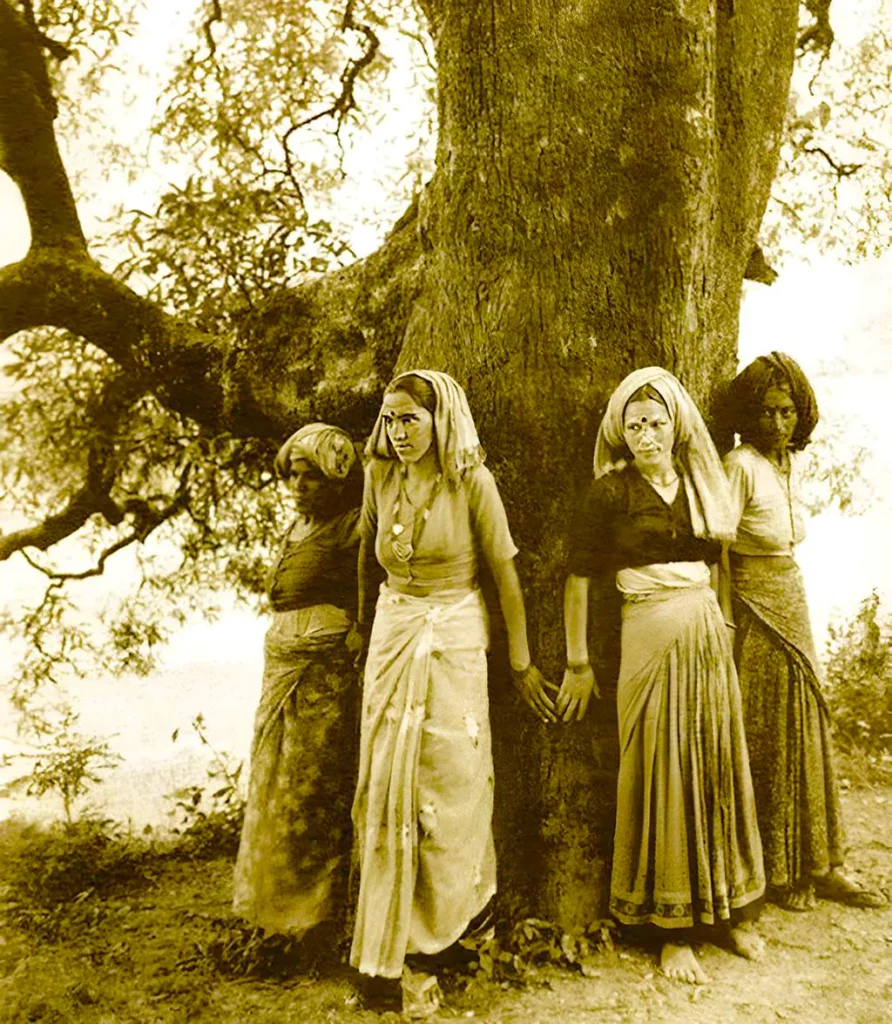One of India’s most recognizable environmental groups, the Chipko Movement began in the 1970s in the Himalayan state of Uttarakhand. The Chipko Movement, which is well-known for its nonviolent protest strategies, was a pivotal period in Indian environmentalist history that highlighted the negative consequences of deforestation and the significance of protecting natural resources. In addition to raising awareness of Uttarakhand’s environmental problems, the campaign served as an inspiration for other ecological movements worldwide. This essay examines the history, importance, and impact of the Chipko Movement of Uttarakhandwhich revolutionized social and environmental activism in India.
Origins of the Chipko Movement

“Chipko” means “to stick” or “to embrace” in Hindi, and it came to represent the movement’s primary protest tactic of hugging trees to stop their destruction. The movement began in the early 1970s when the inhabitants of Uttarakhand, which was then a part of Uttar Pradesh, had to deal with a fast declining natural environment. Commercial logging operations in the area mostly caused deforestation, which was the main factor contributing to the environmental deterioration. The indigenous populations have long relied on Uttarakhand’s forests for commodities including fuelwood, food, timber, and medicinal herbs.
But extensive logging operations carried out by public and commercial entities caused these forests to be lost at a startling rate, Massive natural resource depletion ensued, causing floods, soil erosion, and a drop in agricultural production. These changes had a significant impact on the local population, whose livelihoods depended on the forests.
In 1973, the Chipko Movement had its start in the Uttarakhand village of Reni, which is located in the Garhwal region. When a group of villagers, led by a local leader named Gaura Devi, gathered in front of the trees that contractors scheduled to destroy, the first significant incident occurred. The majority-female villagers embraced the trees to keep the contractors from felling them when the contractors showed up with their axes and chainsaws. The women’s act of disobedience conveyed a strong message throughout the region.
Key Figures and Women’s Involvement

Even though there were many participants in the Chipko Movement, the local women’s efforts were the main force behind it. Since women were the ones who directly experienced the effects of deforestation, their participation in this movement was crucial. The primary task of gathering firewood, fodder, and medicinal herbs from the forests of Uttarakhand fell to women. Their life became more challenging as a result of the loss of forests, since they had to travel farther in search of firewood and food, endangering their health and welfare.
Gaura Devi, a native of the village of Reni, was one of the most well-known members of the Chipko Movement. She spearheaded the first tree-hugging demonstration. Because of her courage and leadership, she became a symbol of environmental activism in Uttarakhand and recruited a group of women to safeguard the trees. Gaura Devi’s dedication and leadership motivated many women to take action and speak out against the degradation of their surroundings.
Another important figure in the campaign was well-known environmentalist and activist Sunderlal Bahuguna. Bahuguna was a social activist and Gandhian who fought relentlessly to increase public awareness of the damaging effects of deforestation and promoted the cause of forest preservation. He popularized the Chipko saying, “Ecology is permanent economy,” which highlights how crucial protecting the environment is to the long-term well-being of humanity. His actions attracted national notice, and he rose to prominence in India’s broader environmental movement.
Strategies of the Chipko Movement
Mahatma Gandhi’s ideas of satyagraha (truth-force) and ahimsa (non-violence) served as the foundation for the Chipko Movement’s primary tactic of nonviolent resistance. The movement protected the woodlands using nonviolent means. Hugging the trees to stop loggers and contractors from felling them was the most iconic action. By doing this, the people of Uttarakhand demonstrated their appreciation for the forests for ecological and spiritual reasons in addition to economic ones.
To raise awareness of their cause, the Chipko activists engaged in several types of protest in addition to hugging trees. In order to persuade the government to halt the commercial exploitation of forests and to grant local communities greater authority over the management of their natural resources, they planned public gatherings, demonstrations, and petition drives. To call for improved forest policy and the preservation of the area’s ecosystems, Sunderlal Bahuguna in particular organized protracted hunger strikes and marches to Delhi.
The active involvement of the local communities, especially the women, was essential to the movement’s success. In addition to preserving trees, the movement aimed to give locals—women in particular—a voice in the utilization of their resources. The movement promoted sustainable forest management techniques and called for striking a balance between environmental preservation and economic growth.
National and Global Impact
Beyond India’s boundaries, the Chipko Movement in Uttarakhand gained national recognition as a symbol of environmental opposition. The movement greatly aided the raising of awareness of the value of trees and their function in preserving ecological balance. At a period when increased urbanization and industrialization threatened natural habitats, the Chipko campaigners successfully brought environmental issues to the attention of the country.
Additionally, the movement sparked more significant revisions to India’s environmental laws. The Indian government put the Forest Conservation Act into effect in 1980 with the intention of controlling the use of forest land for uses other than forestry. The Act directly addressed the concerns of local communities and environmental activists during movements like Chipko.
The Chipko Movement significantly influenced the worldwide environmental movement as well. It served as an inspiration for other campaigns throughout the world and was among the first instances of a grassroots, nonviolent movement centered on environmental conservation. The Chipko activists, especially the women, showed how effective local leadership and group efforts can be in preserving the environment.
Legacy of the Chipko Movement
The Chipko Movement left a lasting legacy in Uttarakhand, India, and the world at large. It changed local forest management techniques in Uttarakhand in addition to increasing awareness of the value of forests. By giving local communities a voice in the use and management of forests, the movement popularized the idea of community-based forestry management.
Additionally, the movement gave women a voice in social and environmental issues, empowering them in Uttarakhand and throughout India. Various observers might consider the Chipko Movement a forerunner of subsequent environmental campaigns led by women, such as the Jungle Bachao Andolan (Save the Forest Movement) and the Narmada Bachao Andolan (Save Narmada Movement).
The Chipko Movement also brought attention to the link between socioeconomic problems and environmental deterioration. Women in particular, who largely depended on the environment for their livelihood, frequently faced disproportionate effects from the exploitation of natural resources. The movement emphasized the necessity of sustainable development strategies that put people’s welfare—especially that of the most vulnerable—first.
Conclusion
A groundbreaking environmental movement, the Chipko Movement of Uttarakhand brought together grassroots action, a strong feeling of community, and a love of the natural world. It pushed for the sustainable use of forests and opposed the commercial exploitation of natural resources, marking a watershed in India’s environmental history. The people of Uttarakhand, particularly the women, showed the strength of local communities in preserving their environment by their nonviolent acts and group efforts.
The movement’s legacy, which emphasizes the need for equilibrium between ecological preservation and economic development, continues to motivate environmental activism in India and abroad. The resilience of communities in defending their rights and conserving their natural legacy for future generations is still demonstrated by the Chipko Movement.


